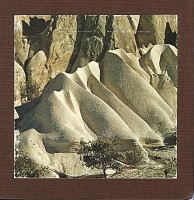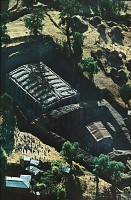It is time for the annual Nativity festival no-tax-20%-off sale! It will be Sunday, December 14. Everything purchased that day will be available for this special.
In his work 'On the Incarnation', Athanasius makes the stunning statement: 'For He was made man that we might be made God'. My reaction to this is always, 'Oh my. Oh my.' It almost suspends thought. 2 Peter 1:4 tells us '. . .He has bestowed on us the precious and very great promise, so that through them you may come to share in the divine nature . . .' And one of my favorites, 1 Cor. 3:22-23: 'Paul or Apollos or Kephas, or the world or life or death, or the present or the future,all belong to you, and you to Christ, and Christ to God.'
There are two books, both published by St. Vladimir's Seminary Press, that address this marvellous concept. The first is Deification in Christ: The Nature of the Human Person, by Panayiotis Nellas. He begins with the idea of Man as the image of God before the fall, and the consequences of that fall whereupon Man became clothed in 'garments of skin'; he becomes mortal, and life becomes survival. After exploring the consequences of this for man and the Church, he turns to the life in Christ which was made possible by the Incarnation: the taking on of the nature of man by Christ. He shows how the living of the spiritual life according to Christ produces man's 'Christification', as well as the 'eschatological transformation of the universe', where the members of His body will be simultaneously Family, Eucharist, and Choir'. He ends with a collection of patristic texts which further elaborate his thoughts.
The other book is The Deification of Man: St. Gregory Palamas and the Orthodox Tradition, by Georgios Mantzaridis. The shape of this book is very similar, and includes a separate chapter on the mystical experience of deification. Both these books provide in-depth understanding of the concept of deification; what its nature is, moral and mystical elements, and its fulfillment.
Just a couple of reminders: there is a book about the Christmas star which is fascinating for those interested in astronomy and the astrology of the Magi, and there are many lovely children's books which would be wonderful gifts.
Susan Noel Reynolds - Shopkeep
It makes my heart happy that the Orthodox are showing more and more interest in the early western saints. For example, the spiralbound lives of the saints that is available in the bookstore every year, had more western saints than ever listed. Being almost totally of British Isles descent, I relish reading about the ancient saints which my ancestors would have been familiar with.
One resource I have been using is The Oxford Dictionary of Saints. It has both pre- and post-schism saints listed, and has more of a scholarly than a devotional approach, but its 526 pages, plus indexes, are a treasury of saints from all places and times. The number of ancient British saints is huge, and many go back to the first centuries of Christianity in Britain. It includes patronages of saints (one of the patron saints of gardeners is Fiacre, a 6th century Irish saint), patrons of certain places, and a calendar one can follow every day. Even for the post-schism saints, the readings enhance one's understanding of history. I was particularly taken with The Forty Martyrs of England and Wales - Roman Catholics who were executed between 1535 and 1679 for refusing to take the Oath of Supremacy acknowledging Henry VIII and his successors to be head of the Church in England, or for simply being Roman Catholic Priests.
There are as well other sources, some of which were contemporaries of their times. Bede's The History of the English Church and People is perhaps the best known and comprehensive of these. It was written in 731 and is a rich tapestry of the times. The Life of St. Columba is another book that gives a good sense of the times of that great saint. He lived between about 521 and 597 in both Ireland and of course the island of Iona, off the Scottish coast. It was written by Adomnan, a kinsman of Columba's that lived about a hundred years after Columba, and who was also abbot of the monastery on Iona. The Penguin Classics edition has nearly a 100-page introduction, and the text itself is extensively notated.
Another interesting book is The Journey Through Wales/The Description of Wales by Gerald of Wales. Although written in the 12th century, it refers to saints from pre-schism times, and is also interesting in a historical sense. For instance, Gerald and Baldwin, Archbishop of Canterbury, visited a church in Llandaff near Cardiff. "The next morning the Cross was preached in Llandaff. The English stood on one side and the Welsh on the other; and from each nation many took the Cross." Hmmm. Such segregation!
Just on a side note, when I was researching last month's article I came upon a curiosity, the Codex Purpureus. These are usually Gospels which are from the 6th century and are written on parchment or vellum that has been dyed purple. I couldn't find a book, but if one googles 'codex purpureus images' there is much online. It is very beautiful!
Susan Noel Reynolds - Shopkeep
I have always been intrigued by remote and strange places. I like to go to them in my mind, if not in fact. Two of the more odd places with tons of Christian history are Cappadocia in central Turkey, and the northern highlands of Ethiopia. They are alike in that in both places there is an abundance of volcanic tuff, a soft, porous rock that is easily eroded both by water and by human hands.
In Cappadocia, home of such great saints as Gregory the Theologian and Basil the Great, the rock has been eroded into wierd and fantastic shapes, the funnest of which are the 'fairy chimneys' - tall, thin columns topped with caps of basalt or andesite. The book, Caves of God: The Monastic Environment of Byzantine Cappadocia, details with many pictures and diagrams the monasteries and churches which have been carved out of the soft tuff. They are definitely not simple structures by any means. In a hermitage at Zilve, for instance, a conjoined group of fairy chimneys has a 3-story hermitage carved into it, And the carved dwellings are not only above ground. There are dwellings of as many as 9 stories underground which are accessed by a single hole, built as protection against invaders. Both inner and outer surfaces are highly decorative; the outside with elaborate carvings, and the inside with iconography and Biblical scenes. The book enumerates the physical setting, the different types of churches, hermitages and their architecture, and the many different types of interior iconography. The text, which could be dry and technical, is accessible and absorbing, full of interesting details about all facets of the area and the life there.
About 330 A.D. a Syrian Christian from Tyre named Frumentius was captured by pirates. He was taken as a slave to Aksum in the interior of Ethiopia, and it is from him that Ethiopian Christianity began. The people there came to call him Abba Salama, of the Father of Peace. Northern Ethiopia is particularly mountainous and rocky. Some of the monasteries are almost inaccessible, for instance the one to which Abba Salama retired in his old age. It can only be reached by scaling a cliff with only finger- and toe-holds, and negotiating a rock chimney. As in Cappadocia, structures are carved out of the living rock, and some are carved directly in a hole in the ground, with the roof at ground level. Out of this tradition comes the book Harp of Glory: Enzira Sebhat. It has been called the African Akathist, as it is a hymn of praise to the Theotokos. It is a series of sections of varying length, each beginning with an invocation to the Holy Trinity, and containing a plethora of Biblical references - sometimes one for every line. It seems to practically fall all over itself trying to surpass each subsequent praise. I will let it speak for itself:
You are the garden where vines and balsam flowers,
where wild crocus and cinnamon abound.
Or rather, you are the fruit arbor of figs,
The orchard of pomegranates and olives. . .
The abyss of your glory is deeper far
than the greatest depths of the ocean,
The sea of your praise is more profound than the great waters.
Neither tongue of men nor angels can tell it all,
Either with a mighty voice, or in quiet speech.
Susan Noel - Shopkeep

Many years ago, when I first started the Bookstore, I was walking to my car up in Wilkeson, and someone stopped me and asked if I could get the book Calmness by Pope Shenouda of the Coptic Church. I could not find it at the time, but its title was so intriguing to me that from time to time I would look in catalogues for it. The other day I decided to Google it, and, lo and behold, there it was on the Coptic Church website, free for the reading, as well as many more titles by him.
This has been a summer of 'wars and rumors of wars', fires, and displacement of thousands of Christians who had to flee from their homes. This book couldn't have come into my hands at a better time. The very first sentence puts the tumult of the world in its place: 'It is but a troubled drop in the peace which has existed since eternity, and will last forever.'
The book, numbering only about 100 short pages, examines the nature and characteristics of authentic calmness, types of calmness, causes of restlessness, and how we can obtain calmness. His writing is very accessible and simple, dancing around all aspects of his subject. He makes a distinction between calmness and cold impassiveness, and points out that some people seem to possess it naturally, but others have to work hard to achieve it. He shows its relationship to the virtues of love, peace, gentleness, depth, humility, and faithful living with God.
He gives examples of calmness, beginning with God Himself: Look at the stillness in which the Incarnation was performed, at how quietly He performs miracles, at the tranquility of Jesus when He dwelt on earth. He then describes the types of calmness: of temperament, of the nerves, of the tongue, of the body and its senses. Causes of a loss of tranquility can come from many sources within oneself, such as temperament and way of thinking, and external to oneself such as the bustle and tension of the world. He quotes St. Arsenios when he heard the sound of the reeds being moved by the wind: 'What is this earthquake?' He ends his little book by giving some practical ways in which we can develop calmness in our own souls: a love and appreciation of it, finding the calmness in the natural world, a wide-open heart, nurturing joy, humility and gentleness and most of all faith that God is continually upholding us and protecting us, so we can leave all things to Him. He follows this with counsels to develop quietness of body, speaking, and patience in dealing with others. He ends by saying: If you are really convinced of the transient nature of the world, you will become calm.
What a joy this little book is!
Susan Noel - Shopkeep
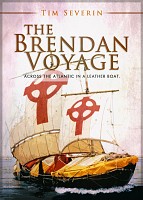
My heart leapt a little when Fr. John mentioned St. Brendan the Navigator as one of the saints of North America. Being a Navy and Sea Scout family (Savannah just left today for a Long Cruise), St. Brendan has always been a special one for us. His story, 'The Navigatio' has been variously called a medieval romance, a spiritual journey, and perhaps a real voyage. For author Tim Severin, it was a detective story; and the text of 'The Navigatio' a 'list of clues . . . that a felony has been committed. The felony was, of course, the discovery of North America several centuries before the date that is generally accepted . . .' The body of clues is remarkably consistent throughout all the existing Latin manuscripts, even down to the numbers and compass bearings, which tend to be the most corrupted elements by copyists, or the most symbolically used. All of this led Severin to attempt to recreate Brendan's voyages in the spirit of Thor Heyerdahl's Kon-Tiki. Extensive research was done in order to replicate what Brendan's boat would have been like: an oak and ash frame covered with ox hides tanned with the bark of oak and smeared with raw wool grease; alum-dressed leather thongs, and flax thread. After many sea trials of different sorts, he and his crew set out, 'The Navigatio' in hand. They set a course following the clues, and it became a series of stepping stones, from Ireland, through Scotland's Hebrides islands, north to the Faroe Islands, west to Iceland, skirting Greenland, and finally southwest to Newfoundland. Especially given that the warmer climate in Brendan's time (c.489 to c.570-583), Severin disproved those who said that the voyage was impossible for a small leather boat. And, when the Norsemen first arrived at the 'stepping stones' on Brendan's voyage, they found that there were already Irish settlers there. Ready to return to Ireland, they returned by a more direct route, 'over the great-waved sea'. They would have been following the same route modern rowing teams follow, using the westerly winds and currents, which land them directly on the west coast of Ireland.
If 'The Brendan Voyage' gives the technical and adventure side of the story, 'The Navigatio' itself gives the spiritual side as well. It says, 'He requested earnestly of the Lord that He would grant him some secret country, far removed from men.' He hears of an island 'The Promised Land of the Saints' and, with fourteen of the brethren, sets out to find it. The resulting tale is full of their prayers, their Feasts, and holy people they encounter on their voyage.
Both of these books would be ideal for a great summer read!
Susan Noel - Shopkeep
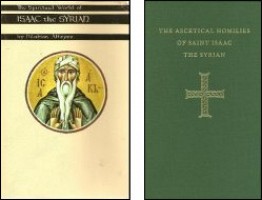
St. Isaac of Syria is one of the most beloved of spiritual writers in the Orthodox Church. There are two books on order for the Bookstore which deal with him in depth. The first is 'The Ascetical Homilies of Saint Isaac the Syrian'. This is a large and rather expensive, but beautifully appointed book containing 77 homilies on various subjects pertaining to the spiritual life. Also included are some introductory articles, one of which is titled "An Offering of Praise to St. Abba Isaac the Syrian, Inadequate for the Sublimity of Its Subject, but Written With Much Love", by Photios Kontoglou. There is a lengthy article giving his life and background as well. Then there are several Appendices giving more of his writings, plus some writings and information about some other Syrian spiritual writers. The book is printed on heavy paper, with red and black text.
Second there is a newer book on St. Isaac, 'The Spiritual World Of Isaac The Syrian', by Bishop Hilarion Alfeyev, who attempts to give 'a balance and comprehensive overview of St. Isaac's life, background, and teaching.' The book is full of quotations selected to allow St. Isaac's true voice to come through, to let him speak for himself. There is an introduction which speaks to Isaac as a spiritual writer. Following that are chapters on various aspects of the spiritual life, such as Humility, the School of Prayer, Trials on the Way to God, and the Life in God. Concluding is a section concerning The Enduring Influence of St. Isaac.
Both of these books will be in the Bookstore soon; the Ascetical Homilies shortly, and Alfeyev's book in a couple of weeks. Either one is worth a look!
Susan Noel - Shopkeep

The world of Orthodox children's books has recently become brighter. When I first started the bookstore, the offerings were few, and of varying poor quality, especially the illustrations. Then with the publication of books with the wonderful illustrations by Niko Chocheli, things started looking up. Slowly there appeared more and more nice children's books, until today there is quite a range of books on the Church life, saints stories, and stories of children living their faith. Unfortunately, because these books are published on a much smaller scale than in the general book trade, the prices are normally higher than a non-Orthodox book of the same type would be. But I think the main consideration is not so much price, but the way these books can add to the foundation that Orthodox families try to establish for their children. I still remember so many books from my childhood that have been a part of me ever since. (I don't really remember memorizing poems from A Child's Garden of Verses, but I can still quote them today.)
There is a new book published by the Greek Orthodox Monastery of the Theotokos of the Life-Giving Spring in Dunlap, California, called 'Rejoice, Panagia: Offering to Children the Akathist Hymn'. This is one of the most beautiful hymns of the Church, and it is presented here in simple words for children. The illustrations are icons painted by the sisters which grace the walls of the monastery's Dormition chapel. It is hard cover, and 62 pages, and from the outside covers, it looks like it is an excellent publication. The cost is $30.00 and I have ordered 5, and can get more quickly if there is a demand.
So with Pascha coming up, in addition to the toys and goodies, consider a gift of a fine Orthodox book, which will live in their hearts and minds. Being introduced as a young child to the beauty and sweetness of Orthodox life and the saints that have lived it, can set a tone for their whole lives.
Susan Noel - Shopkeep
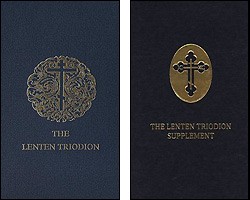
The other day I said to someone that reading the Lenten Triodion and the daily Triodion Supplement had completely changed the way I look at Great Lent. I used to see it in a pretty negative way, I must admit, perhaps a leftover from my days before Orthodoxy. Can't eat this, can't do that, oh now I feel guilty for not going to every service that's offered. Early on, Fr. John suggested I read the material in the Triodion. It showed me that the emphasis is on looking towards the heavenly life, and what is that but beauty, sweetness, light and love. The thing that makes it so hard is our looking backwards to the things of this earth, and breaking our attachments to these is where it is painful.
So I thought a selection of passages from the Triodion would give a sampling of the treasures found in it.
"The holy season of abstinence shines upon us all with the light of repentance, driving away the darkness of sin."
"Let us welcome the Fast with willing hearts.
Shining upon us as the dawn, the grace-giving Fast provides us now with a time for repentance, dispersing the darkness of our sins."
"Let us joyfully begin the all-hallowed season of abstinence; and let us shine with the bright radiance of the holy commandments of Christ our God, with the brightness and love and the splendour of prayer, with the purity of holiness and the strength of good courage. So, clothed in the raiment of light, let us hasten to the Holy Resurrection on the third day, that shines upon the world with the glory of eternal light."
"Setting before us a mystic table, the Fast invites us all to take our fill. Our food shall be the everlasting gifts of the Spirit; our drin, divinely flowing streams of tears. Let us make glad and without ceasing offer praise to God."
"O my soul, fast from wickedness and take thy delight in divine love. Open wide the door to every thought of good, and by abstinence and prayer guard the entrance against evil."
"O brethren, come and let us delight in the Fast, for it is the Father's treasury, a thing of wonder, and the mother of all who worship Christ the Master. It gives strength to the body and light to the mind and heart.
"Entering as initiates into the dazzling grace of the Fast, let us shine as lightning with the virtues, and by our peaceful faces and our peaceful way of life let us display the peace that is within our souls."
"Fleeing ffom the icy cold of self-indulgence, let us all warm ourselves with the light of abstinence and th Holy Spirit."
"Beset by the storm of temptations, drowning in the waves of passion, and assailed by the tempest of lust, I have now reached the sea of the Fast that is mild and calm. Pilot me across it by Thy Crpss. O compassionate Lord, and bring me to the harbour of salvation."
"The bright and joyful day of abstinence is at hand. Come, my soul, with joyful face let us go to meet the Master, asking Him to send down grace upon us from on high . . ."
May it be so.
Susan Noel - Shopkeep
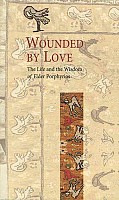
It's taking me a really long time to read the book I'm reading on my lunch break at school. The reason is that I keep finding so many meaningful things to write down, I don't get too far before I need to write down something else. The book is Wounded by Love by Elder Porphyrios. He was a Greek monk who lived between 1906 and 1991. The book was compiled from many of his writings, and put together to form a coherent whole, in which he tells his own story and speaks on various spiritual topics such as spiritual struggle, love for one's neighbour, the upbringing of children and prayer. His narrative is simple and direct, with a guileless quality.
Elder Porphyrios counsels us to keep looking at Christ, no matter what; to fill our heart and eyes and minds with Him. We are to do this 'in simplicity of heart and artlessness . . .So that's how you should engage in your spiritual struggle: simply, gently, and without force. If we 'open a tiny aperture (in our soul) for light to enter, the darkness will disappear. . . Read the (holy books of the Church with joy and love and exaltation . ..and your soul will be sanctified in a gentle and mystical way without your even being aware of it.' The more we fill our lives with the things of goodness and light, the more we approach God, 'the more careful you are - without trying to be - in all things, including spiritual things.
It reminds me of what St. John Chrysostom said: 'If you change from inhumanity to almsgiving, you have stretched forth the hand that was withered. If you withdraw from the theaters and go to church, you have cured the lame foot. If you draw back your eyes from beauty not your own, you have opened them when they were blind. If, instead of satanical songs, you have learned spiritual psalms, being dumb, you have spoken.' If we do everything we can to abide in the mystery of the Church, and 'let all your strength be turned toward God, in this way your release from evil and from your weaknesses will happen in a mystical manner.' Ours is to struggle quietly, calmly, with simplicity, humility, and steadfast faith and love: His is to heal us, to fill us with light, and to unite us to Christ in His Holy Church.
Susan Noel - Shopkeep
Abba Isaac says somewhere that there was a monk who covered the wall of his cell with sayings. When a visitor asked what's all this, he said: 'These are the things I write down when grace visits me. And when grace leaves me, I read them and draw strength from them.' " When I read that it made me happy because I do something similar, and derive much benefit from it. I'm famous for reading something, and when I try to tell someone about it or remember it myself, I don't get it quite right, which frustrates me. So I started writing these things down; at first randomly, but then more systematically with book and page number, in case I want to refer back to the context in which the quote appeared.
Some things I write down just because they are beautiful, some are instructive, some reveal something about me that I hadn't known before. I've also found that sometimes if I'm working on a particular difficulty, I often stumble upon many passages that apply specifically and help me work things out. At those times I may write some of my own words of observation, contemplation or struggle, thereby weaving the words of Scripture, and those of the saints and elders of the Church into my own thought processes. I suppose this is something like journaling, which I also do; but it is, I think, something more. In our efforts to become more and more Christlike, we need to look to the examples of those who have written down the tales of their own struggles, and follow them with our own particular inner struggles. I am no happier than when I find a book in which a person who has gone much further along the road has enumerated how he got there! I know, for example, that I should have humility, but how does it work? How do you get there? How do you know if something is real? Reading these works, writing down the things that strike us, and digesting them so they become part of our processing can help to define our particular struggles, which we can then take to Confession and receive the power of that Sacrament .
Another benefit of writing these passages down, is that often in our lives we revisit the same difficulties, only in a different or deeper way. Then we can go back to the writings which helped us before, and our understanding of them can be enlarged or deepened. I love what Bishop Epiphanius of Cypress said: "The acquisition of Christian books is necessary for those who can use them. For the mere sight of these books renders us less inclined to sin and incites us to believe more firmly in righteousness." I feel somewhat the same about my little notebook full of passages.
Susan Noel - Shopkeep

